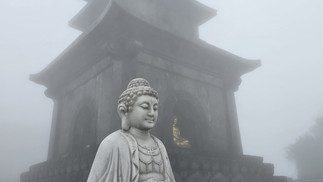Beyond the Mist - Exploring Sa Pa’s Hidden Histories and Highland Charm
- shan157
- 5 days ago
- 4 min read
Tucked high in the Hoàng Liên Son Mountains of northwestern Vietnam, Sa Pa’s history predates the modern tourism boom by centuries. Archaeological discoveries suggest that humans have inhabited this rugged region for thousands of years. Stone tools, ceramic fragments and burial items uncovered in the Muong Hoa Valley point to a Neolithic culture that once thrived along the riverbanks. These finds, some dating back over 3000 years, are among the earliest signs of settled life in Vietnam’s mountainous north.

By the first millennium AD, Sa Pa and its surroundings were inhabited by various ethnic groups who migrated from southern China, including the Hmong, Dao (Yao), Tay and Giay. These groups brought with them unique languages, agricultural techniques and animist spiritual beliefs. Terraced rice farming, an iconic image of Sa Pa today, was developed over generations to adapt to the steep terrain. Oral histories passed down through these communities speak of spirits in the mountains, sacred trees and ancient battles over territory and resources.

The region remained relatively autonomous until the late 19th century, when French colonial forces arrived in northern Vietnam. By the early 1900s, the French had recognised the area’s cool climate as an escape from the heat of the Red River Delta. In 1903, Sa Pa was officially mapped by the French and by 1912, it had become a hill station with sanatoriums, villas and a military post. A stone Catholic church was erected in 1935, still standing today as a central landmark. However, much of the original colonial architecture was destroyed during the First Indochina War between 1946 & 1954.

Sa Pa’s population and its strategic importance, fluctuated dramatically during the 20th century. During the Vietnam War, the area was largely cut off due to its remoteness and proximity to the Chinese border. The post-war era brought further isolation and it wasn’t until the 1990s, with the opening of Vietnam to tourism and market reforms, that Sa Pa reemerged as a destination. The 1993 legalisation of foreign tourism led to rapid infrastructure development, though often at the cost of environmental and cultural integrity.

One lesser-known chapter of Sa Pa’s history involves its role in border tensions. In 1979, during the brief but intense Sino-Vietnamese War, Chinese troops entered Lao Cai Province, damaging infrastructure and displacing local communities, including many in Sa Pa. Though often glossed over in tourist narratives, this conflict left a lasting psychological imprint on the region and heightened the central government’s focus on the northern borderlands.

In terms of folklore, Sa Pa is rich in local legends that blend history with mysticism. One enduring tale from the Hmong people involves a spirit known as “Ma Doi,” said to haunt certain trails and grave sites in the mountains, particularly near Fansipan, the “Roof of Indochina.” According to lore, the spirit guards the mountain’s sacred places and punishes those who disrespect the land or fail to give offerings. These stories are not simply superstition, they form part of the moral and ecological framework that governs traditional life.

Another dark piece of lore tied to Sa Pa is the “Rock of Curses” in the Muong Hoa Valley. Locals say this moss-covered boulder, etched with ancient carvings, can bring misfortune if defiled. The rock is among over 150 petroglyphs scattered across the valley, thought to date between 500 and 2000 years old. While some believe these symbols mark ancient tribal boundaries or record celestial events, others see them as mystical warnings. The true meaning remains undeciphered but the carvings have been protected as part of a UNESCO-recognised heritage zone.
Today, Sa Pa’s layered history is often hidden beneath its image as a scenic retreat. Yet behind the mist-covered rice terraces and bustling markets lies a region shaped by ancient migrations, colonial incursions, war and resilience. Its past, preserved in legends, ruins and rock carvings, remains deeply embedded in the cultural memory of its people, even as modernity carves new paths into the mountains. However, modern development has also brought darker realities. The exploitation of ethnic minority children, often forced into street vending or trafficked across borders, remains a serious and ongoing issue in the region, one frequently overlooked by visitors drawn to its beauty.

Location : Sa Pa Town, Sa Pa District, Lào Cai Province, Việt Nam
How to get there : Sa Pa is about 320 - 350 km from Hanoi and can be reached by train, bus, or private car. Overnight trains to Lào Cai take around 8 - 9 hours, followed by a 1 1/2 hour transfer to Sa Pa, with total costs ranging from 150000 to 2900000 VND, depending on seat class. Direct buses take 5 1/2 - 7 hours and cost between 250000 and 750000 VND, offering various comfort levels. Private cars are the fastest and most flexible option (5–6 hours), with prices ranging from 2400000 to 4500000 VND, depending on vehicle size. Each option suits different travel styles and budgets.
Attraction Info : Sa Pa offers a mix of accommodations from budget hostels and homestays to luxury resorts with mountain views. Its restaurants and cafés serve local Vietnamese dishes, ethnic specialties and international food. Visitors can enjoy trekking through terraced rice fields and ethnic villages, visit the cable car to Mount Fansipan, explore local markets and see cultural sites like the stone church and ancient rock carvings in Mường Hoa Valley. You will need about 3 - 4 days in the Sa Pa area to fully experience its natural beauty, cultural sites, trekking routes, markets and local cuisine. The Grab app works here and is the cheapest way to organise transport around the area.
Website : https://sapa-tourism.com/
Thanks for reading Beyond the Mist - Exploring Sa Pa’s Hidden Histories and Highland Charm. Check out more destinations here!












































































